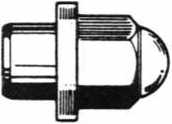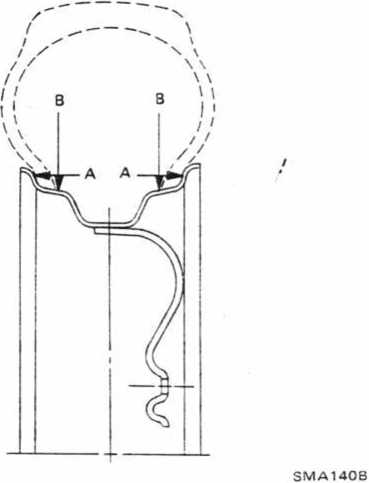50
CHASSIS AND BODY MAINTENANCE
Wheel Nut
Wheel Inspection
For spare wheels only

For Steel wheels only

CAUTION:
• Three types of wheel nuts are used; one is designed for use with Steel wheels, one is designed for use with aluminum wheels and the other for use with spare wheel. Do not mix different types of wheel nuts.
• Be careful not to smear threaded portion of bolt and nut, and seat of nut with oil or grease.
For aluminum wheels only

98 - 118 N m (10.0 - 12.0 kg-m, 72 - 87 ft-lbl
SMA438
Tire Repair
CAUTION:
When replacing tire, take extra care not to damage tire bead, rim-flange and bead seat.
When installing tire, notę the following items:
a. Install valve core and inflate to proper pressure. Check the locating rings of the tire to be surę they show around the rim flanges on both sides.
b. Check valves for leakage after inflating tires.
c. Be surę to tighten valve caps firmly by hand.
• Check wheel rim (especially rim flange and bead seat) for rust, distortion, cracks or other damage.
• Examine wheel rim for lateral and radial runout, using dial gauge.
Lateral runout (A) and radial runout (B):
Steel wheel ... Less than 1.0 mm (0.039 in)
Aluminum wheel ... Less than 0.5 mm (0.020 in)
Mechanical average (C) between righlt and left radial runout.
Steel wheel ... Less than 0.5 mm (0.020 in)
Aluminum wheel ... Less than 0.2 mm (0.008 in)

WARNING:
When, while tire is being inflated, bead snaps over safety hump, it might break. Thus, to avoid serious personal injury, never stand over tire when inflating it. Never inflate to a pressure greater than 40 psi (275 kPa). If beads fail to seat at that pressure, deflate the tire, lubricate it again, and then reinflate it. If the tire is overinflated, the bead might break, possibly resulting in serious persona! injury.
• Replace wheel if any of the following con-ditions occur.
a. Bent, dented or heavily rusted
b. Elongated bolt holes
c. Excessive lateral or radial runout
d. Air leaks through welds
e. Wheel nuts will not stay tight
iV7 vi5Ł” -id! »o .Twfls ;v,* iti. ;or*. oG .. ?'.: !iov -ir o . :• i.-t zon oG
Wyszukiwarka
Podobne podstrony:
CHASSIS AND BODY MAINTENANCE _Checking Front Wheel_ Bearing Grease • Check that wheel bearings opera
CHASSIS AND BODY MAINTENANCEChecking Front Axle and Front Suspension Parts • Check axle and suspensi
CHASSIS AND BODY MAINTENANCE.Checking Rear Axle and. Rear Suspension Parts.Checking Brake Fluid Leve
CHASSIS AND BODY MAINTENANCE—Checking Brake Booster Function_ s;5s>3 J • Make
CHASSIS AND BODY MAINTENANCE.Checking Drum Brake. Check condition of drum brake components. Lining:
CHASSIS AND BODY MAINTENANCEiition..Checking Tire Condition (Cont d)..Tire Rotation. ear ies. Abnorm
CHASSIS AND BODY MAINTENANCE__Tire Replacement_ CAUTION: • Different types of tire
CHASSIS AND BODY MAINTENANCE_Body-LUBRICATING LOCKS, HINGES AND HOOD LATCHES ____C
fSERVICE DATA AND SPECIFICATIONS (S.D.S.)_Chassis and Body Maintenance_ BrakeINSPECTION AND
SERVICE DATA AND SPECIFICATIONS (S.D.S.)-Chassis and Body Maintenance--(Cont d) TIGHTEIMING
CHASSIS AND BODY MAINTENANCE __Checking A/T Fluid Level_ The dipstick can check the fluid level at
2. Measure toe-in. FrontCHASSIS AND BODY MAINTENANCE _Checking Wheel Alignment (Cont d)_ Lines paral
4.5.3 Relationship between metabolic performance and body composition 4.5.3.1 BMR Considering data f
ICHASSIS AND BODY MAINTENANCEBaiancing WheelsSpare Tire (P155/80 Dl2) • This spare
E E is for eat. Eał good foods to help your teeth and body grow. T~-- I K-- I h~J -JU___W
ENGINE MAINTENANCEBefore Engine Starts CHECKING DRIVE BELT 1. Inspect for cracks f
41 776fe880e4 INSP ADJ mrm INTRODUCTION/PERIODIC MAINTENANCE/ LUBRICATION INTERVALSPERIODIC INSPE
więcej podobnych podstron